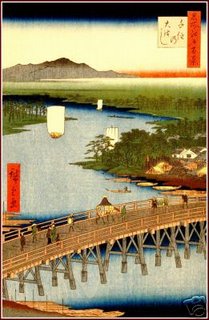 arthur wesley dow grew up in ipswich, massachusetts, which he ended up memorializing in woodblock prints and paintings.
arthur wesley dow grew up in ipswich, massachusetts, which he ended up memorializing in woodblock prints and paintings. having gone to paris to continue his art education, and to learn from other painters, dow eventually returned to ipswich somewhat disillusioned. though he had learned something about 'plein air' painting (the essential underpinning of impressionism), he felt dissatisfied.
having gone to paris to continue his art education, and to learn from other painters, dow eventually returned to ipswich somewhat disillusioned. though he had learned something about 'plein air' painting (the essential underpinning of impressionism), he felt dissatisfied.in france, however, like everyone else at that turn of the century, became aware of the arts and
crafts of japan. when he
returned he continued, and intensified, his interest--so much so in fact that he was made assistant to ernest fenollosa in the asian art department of the mfa boston.
 this study, and a long trip to japan revolu- tionized how dow thought about art, design, media.... and not only did it revolutionize his own work, but those of subsequent generations as dow began to teach, and his students began to teach, and so on.
this study, and a long trip to japan revolu- tionized how dow thought about art, design, media.... and not only did it revolutionize his own work, but those of subsequent generations as dow began to teach, and his students began to teach, and so on. follow- ing precepts he had gath- ered from long study of japanese art, asian concepts of space, balance, clarity, and simplicity became known as what he did, and what he taught.
follow- ing precepts he had gath- ered from long study of japanese art, asian concepts of space, balance, clarity, and simplicity became known as what he did, and what he taught.(left: arthur wesley dow, lilies, and 'the bend';
right: 'bridge at senju' by utagawa hiroshige,
'lily garden' by shoun yamamoto)
right: 'bridge at senju' by utagawa hiroshige,
'lily garden' by shoun yamamoto)



